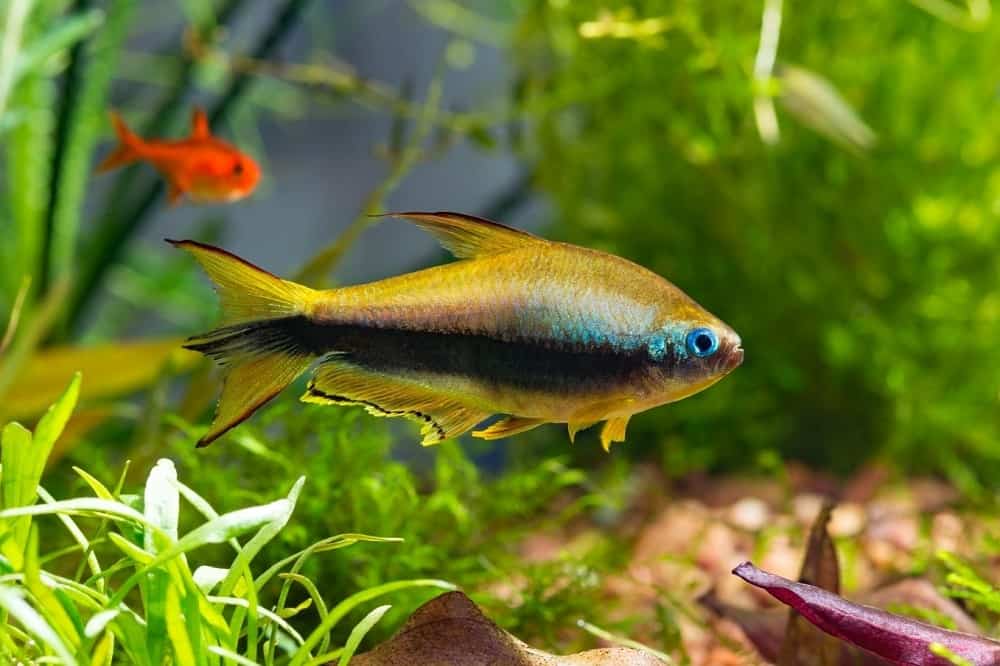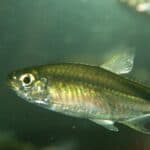The emperor tetra is a schooling fish found in Colombia’s Rio San Juan and Rio Atrato river basins. These vibrant schoolers are known for being low-maintenance and adaptable to a variety of aquarium conditions, making them an excellent choice for novices.
Though they flourish best under conditions similar to those found in their native Amazonian settings.

Care Guide
Tank Size
Before you settle on owning Emperor Tetras, you’ll need to consider the size of your tank. It’s important that these types of fish live in a large tank community. If you plan on only housing Tetras in your tank, then a handful will be able to thrive in a small 10 gallon tank. However, try to get a tank that’s around 20 gallons just in case. A larger tank is always necessary if you plan on housing a large group.
Emperor Tetras love their personal space and will need a lot of room to swim around, so you should avoid overcrowding a smaller tank. A minimum tank size of 30 gallons is recommended for shared tanks with other fish species.
Tank Mates
Emperor Tetras thrive in groupings of six or seven. Because male Tetras tend to be hostile and unpredictable, it is best to keep only one male inside your tank. This avoids any violence and maintains order in the tank. If you don’t want to keep a massive group, this species can also be kept as a single mated couple. There are numerous different species of fish to explore as tank mates. Any equally sized gentle species will suffice.
Generally, you’ll want to keep tank mates from South America who have comparable habitat requirements. It is also critical to avoid larger fish that may confuse the Emperor Tetra for food.
Some suitable tank mates for Emperor Tetra include Ember Tetras, Celestial Pearl Danio, Pearl Gourami, Cory Catfish, Pencil fish, Honey Gourami, Serpae Tetra, Sparkling Gourami, Apistogramma, most Guppies, Platies and Dwarf Gourami.
Same Species Tanks
Male tetras have been known to occasionally confront one another for control of the group, despite being a relatively calm fish . Thankfully, these quarrels do not usually cause significant damage. However, if you wish to discourage conflict in any case, increasing the size of the tank or decreasing the male-to-female ratio will create less chance for conflict.
Because the emperor tetra is a territorial fish, there is only one alpha male in the school, who has claimed the most territory. When defending its territory, the male swims and leans forward, causing its tail to rise 45 degrees up and resemble a crown.
Water Parameters
The best approach to keep Emperor Tetras healthy is to mimic natural water conditions. Fortunately, most people’s homes make it rather simple to do so. These fish reside in slow-moving streams in the wilderness. The water is somewhat hard and warm.
To keep your Emperor Tetras as healthy as possible, the optimal tank temperature is around 73 degrees fahrenheit – 81 degrees fahrenheit. If you aim for a temperature somewhere between these two figures, that would be ideal.
The pH levels of your tank should be no lower than 5.0 and no higher than 7.8. Additionally, as mentioned above, the water will need to be somewhat hard. So, the hardness is recommended to be kept 3 to 8 dKH.
While Emperor Tetras may adapt to a variety of environments, it is better to maintain conditions and try to keep them as consistent as possible. Serious water changes can have a harmful impact on these fish. As a result, it is critical to undertake regular water changes and provide the tank with a robust filtering system capable of keeping ammonia levels low.
What To Put In Their Tank
Unless you were to travel to South America and check out the Emperor Tetra’s natural environment, you might find that the rivers are dark and densely forested. Because of these environmental factors, this species requires dim lighting with some good hiding spots.
You can begin by adding some dark-colored sediment on the tank’s floor. You can make use of gravel. Dark-colored sand, on the other hand, is more similar to what is seen in natural streams and rivers. Include live plants into the tank’s design. These plants will serve as hiding places, places to explore, and places to seek refuge from the sun. Floating flora with a lot of leaves can be added. Java fern and water sprite are both excellent choices.
Plants should be placed everywhere around the tank. However, make absolutely sure there is still enough room for the fish to move about without becoming caught in the foliage. Decorations can be put on top of the layer of gravel or sand at the bottom of the tank. Driftwood, rocks, and even plastic tank ornaments can be used too.
A low-powered lamp and an appropriate filter are required for tank gear. A dependable hang-on-back filtering system should suffice. Nevertheless, you should check that the filter’s water outlet does not create an excessive amount of flow. If required, arrange plants or decorations in a particular way to reduce water disruption.
Common Diseases
There seem to be no illnesses that are known to influence the Emperor Tetra species overall. They can, however, contract a variety of typical freshwater fish diseases. Ich, gill flukes, and other diseases are among the most widespread.
Ich is a parasite disease that causes white patches to appear all over the body. It is very contagious and can spread swiftly in a closed environment. Fortunately, it is simple to cure with copper-based medications.
Another disease that can harm Emperor Tetras is gill flukes. This one clings to the gills. It creates obvious inflammation and has the potential to be lethal if not treated promptly.
You’ll also need to be aware of fungal and bacterial diseases. These conditions can cause unwelcome growths or noticeable rashes on the body. But fortunately, all of these diseases can be avoided. In most situations, poor living conditions and stress are the direct causes of health problems. As long as you keep your tank in good condition, you should have few problems.
Food & Diet
The emperor tetra is omnivorous, albeit not a particularly selective one. Because these fish’s jaws are so little, make sure the product you’re feeding them is the right size.
A high-quality commercial flake food can serve as the foundation of their diet. They’ll eat baby brine shrimp, bloodworms, or mosquito larvae on occasion. Baby brine shrimp and other little shrimp will be eaten by the emperor tetra. Larger shrimp, on the other hand, will be fine in the tank.
Lifespan
A well-cared-for emperor tetra can live for up to six years if properly cared for. This is rare for a little fish. As always, maintaining high water quality, matching them with suitable tank mates, and giving them a nutritious diet can keep them alive longer as well as providing them with a happier, healthier life.
Appearance
This fish has a long, slender body with glistening scales in the usual royal colours of purple and gold. A thick, black line runs the length of the body, from behind the eye to the tail fin.
In certain cases, a blue neon line will appear above the black one, with a lighter belly beneath. The colouring of this fish is remarkable since it changes depending on the sunlight. The scales can appear almost golden in stronger light. They seem purple in low light.
The fins of this tetra are a flowing yellow bordered with black. The male of the species has longer dorsal and tail fins than the female. The male’s tail fin is particularly appealing because the black line that runs the length of the body continues into a pointed, expanded middle region, giving the tail a three-pronged appearance.
The shape of the tail is not the only distinction between men and females. Males are larger and more streamlined, whereas females are smaller and more rounded in shape. In addition, male emperor tetras have vivid blue eyes, and females have green eyes.
Size
The emperor tetra is a tiny tetra species that grows to be around two inches (5 cm) long as an adult. Consider their diminutive size when choosing tank mates, and avoid pairing them with larger, more aggressive fish that may perceive the little tetras as food.
Behavior & Temperament
Emperor tetras are aggressive, darting swimmers who spend the most of their time in the tank’s middle to upper levels.
They will also spend time exploring the bottom and swimming among the plant leaves. This fish is peaceful and gets along well with other species. Keeping the tetras in groups of five to ten can help you achieve a more serene tank.
Breeding
Feed your fish a nutrient-dense diet, including live items, for a few days before transferring them to the breeding tank to prepare them for breeding. When the female is ready to produce eggs, you may see her abdomen growing more rounded.
The spawning process usually starts in the morning and lasts a few hours, during which the female can lay up to 100 eggs. The eggs will be fertilised by the male as she lays them.
Remove the parents from the breeding tank once spawning is complete to prevent them from consuming the eggs. The eggs are expected to hatch in one to three days.
Gender differences: Male vs. Female
The first step in breeding your emperor tetras is determining which are males and which are females. Fortunately, there are some simple ways to tell.
The female will be smaller overall, but with a larger abdomen. She will have green eyes as well. Males are larger, with blue eyes, and a tail fin with an expanded centre ray.
Fun Facts
- The tetra fish species is one of the most well-known and popular freshwater fish kept in aquariums and tanks around the world. There are over 150 species of tetra fishes recognised. Freshwater tetras are fairly simple to keep in aquariums and tanks.
- Female tetras are reported to lay a large number of eggs on a leaf in the water. When the environment in their fish tank changes, they tend to die quickly. Neon tetras can even consume their offspring from the breeding tank.








